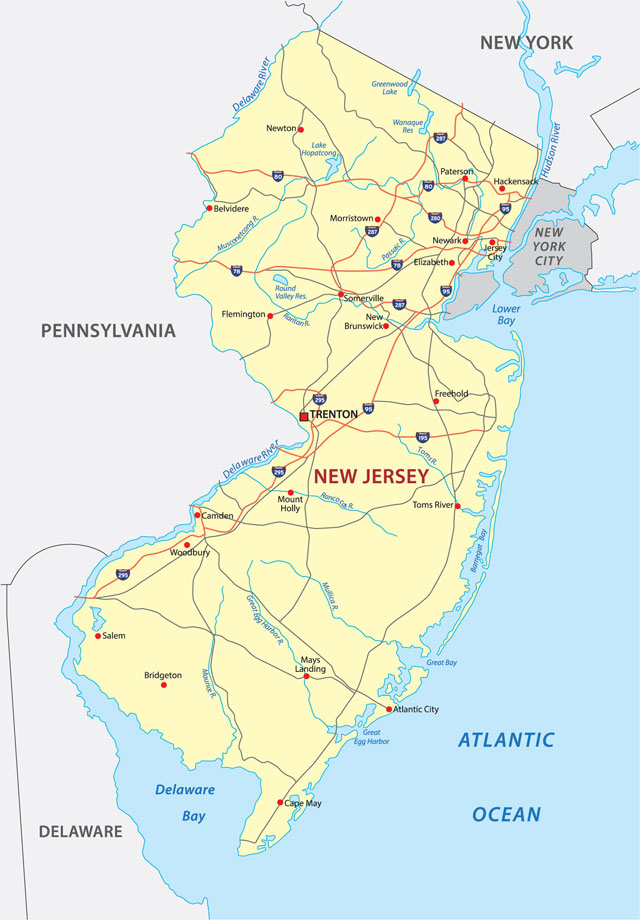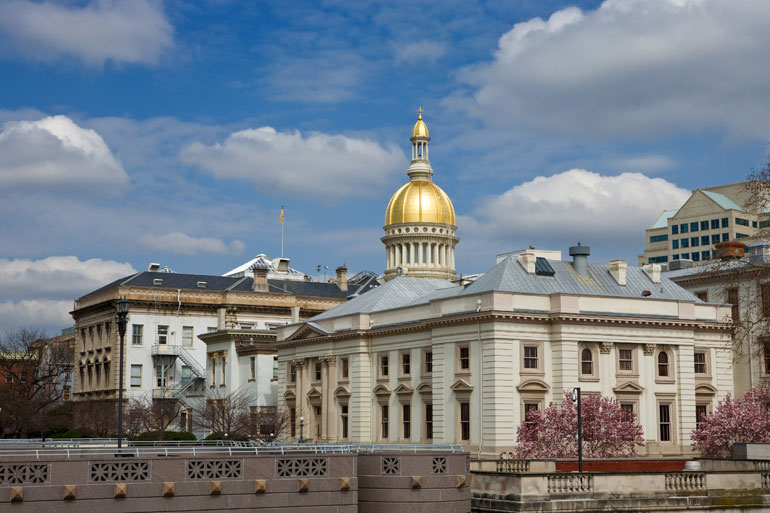New Jersey is made up of four geographic regions: the Ridge and Valley section in the northwest, where the Appalachian Mountains slice across the state. To the east and south is the Highlands, an area of many natural lakes and steep ridges, including the Ramapo Mountains, part of the Appalachian mountain chain. East of the Highlands is the Piedmont area, where many of the major cities and suburbs are located, and which contains the Palisades, a column of rock rising about 500 ft (150 m) above the Hudson River. The Atlantic Coastal Plain, a flat area with swamps and sandy beaches, claims the remaining two-thirds of the state and includes the Pine Barrens, 760 sq mi (1,968 sq km) of pitch pines and white oaks.
Around 550 to 600 million years ago, New Jersey’s topography was the opposite of what it is now, with mountains to the east and a shallow sea to the west. Volcanic eruptions about 225 million years ago caused these eastern mountains to sink and new peaks to rise in the northwest; the lava flow formed the Watchung Mountains and the Palisades. The shoreline settled into its present shape at least 10,000 years ago.
Lakes and ponds cover about 300 square miles (780 square km) of New Jersey. New Jersey’s major river is the Delaware, which is shared with Pennsylvania and makes up the western border between the two states. Over many thousands of years, the Delaware River sliced through the Kittatinny Mountain Range, forming a wide, deep water gap, or break, named the Delaware Water Gap. The Hudson River separates the state from New York. Other major rivers include the Passaic and the Hackensack, in the northeast, and the Raritan, which runs west to east. The largest natural lake is Lake Hopatcong, which is about 8mi (13km) long. Delaware Bay is a large estuary and the outlet of the Delaware River. It's an estimated 782sq mi in area, and its water mixes for many miles with the waters of the Atlantic Ocean.
Most of New Jersey has a moderate climate, with cold winters and warm, humid summers. The northwestern hills have slighter colder winter temperatures and slightly milder summer temperatures than in the rest of the state. In the northwest, average January temperatures are below 28°F (-2°C); while in the south, average winter temperatures are above freezing. Average summer temperatures range from about 70°F (21°C) in the northwest to more than 76°F (24°C) in the southwest. New Jersey receives around 46 in (117 cm) of rain each year, and around 16 in (41 cm) of snow. The record high temperature is 110°F (43°C), set in Runyon on 10 July 1936; the record low is -34°F (-37°C), set in River Vale on 5 January 1904. Occasional hurricanes and violent spring storms can cause severe damage. In 2012, Hurricane Sandy became the worst hurricane on record, killing 37 and causing nearly $30 billion in damages, including the worst power outage in state history, blacking out over 2 million households.




